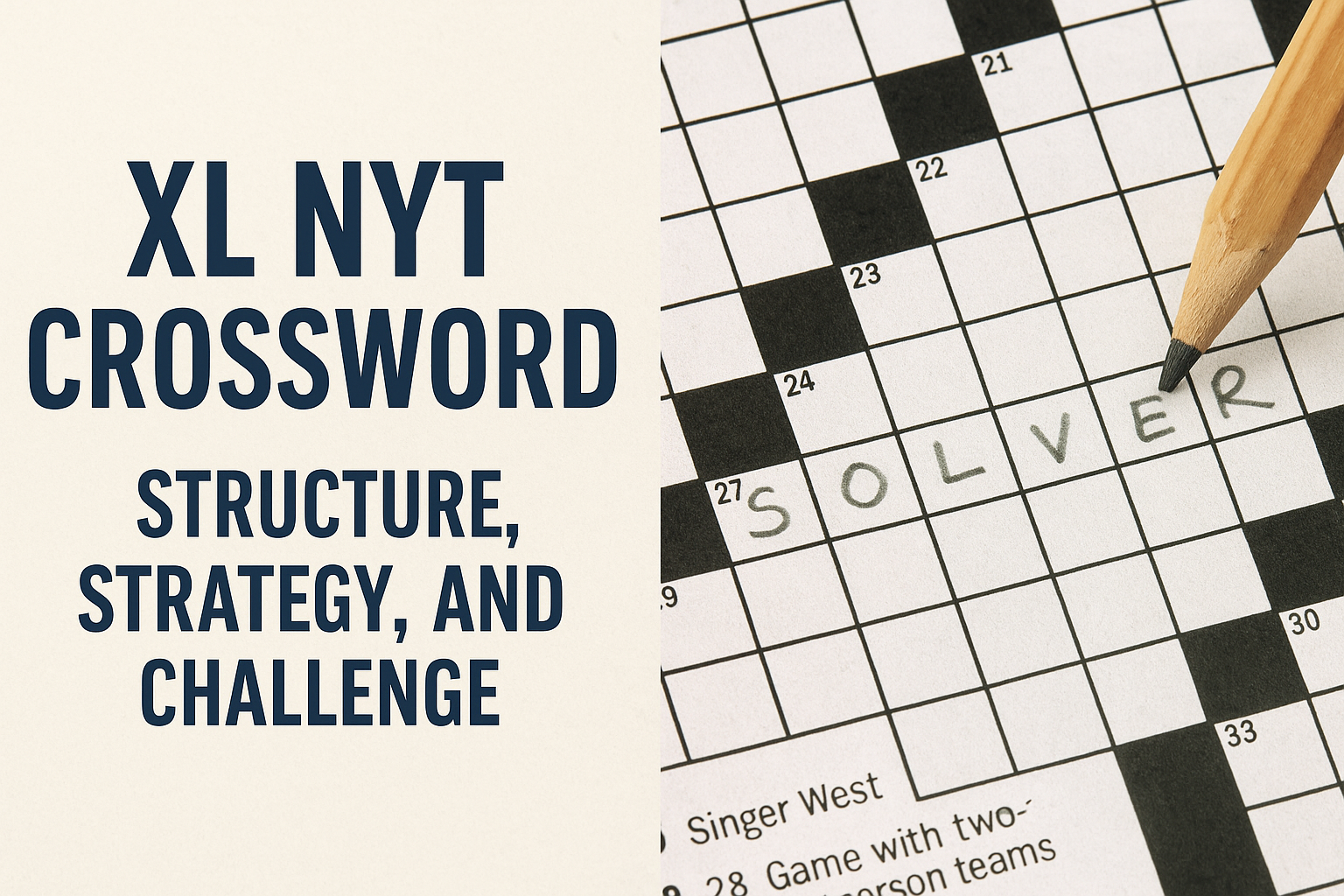Introduction
The XL NYT Crossword is one of the most extended and difficult formats in the New York Times crossword series. Known for its Sunday-level complexity and grid size that stretches beyond the standard dimensions, the XL crossword has become a favorite among seasoned solvers seeking a greater challenge. This article explores the origins, unique characteristics, techniques for solving, and what solvers can expect from the XL NYT Crossword in the future.
Source of the XL NYT Crossword
The XL NYT Crossword originates from the same editorial team that produces the daily New York Times puzzles, under the leadership of puzzle editor Will Shortz. While standard daily puzzles range from 15×15 (Monday to Saturday) to 21×21 (Sunday), the XL format typically exceeds these dimensions, offering 23×23 or larger grids on special occasions. These puzzles are not a daily feature but often appear during holidays or events such as July 4th, Thanksgiving, or special anniversaries in the publication’s history. The editorial process for the XL crossword involves contributions from experienced constructors with a track record of building high-quality, intricate puzzles. Editors prioritize fair but challenging clues and aim to create a balanced experience that stretches solvers’ vocabularies, cultural knowledge, and logical reasoning.
What Sets Apart the XL NYT Crossword
The defining feature of the XL NYT Crossword is its size and the complexity that comes with it. While regular puzzles increase slightly in difficulty through the week (Monday being easiest and Saturday the hardest), the XL crossword tends to maintain a uniformly high level of difficulty throughout. The size alone demands greater stamina, and longer entries often require deeper general knowledge, obscure references, or clever wordplay.
Key characteristics include:
- Grid Size: Often larger than the 21×21 Sunday grid.
- Clue Count: Frequently over 150 clues, making it a time-consuming puzzle.
- Entry Length: Long across and down entries with interlocking answers that require contextual awareness.
- Themes: While some XL puzzles are themeless, many feature elaborate, multi-part themes, sometimes including rebus squares or meta-puzzle elements.
- Publication Frequency: Occasional, often during holidays or as part of commemorative issues.
Due to these elements, the XL crossword stands out as a test not just of knowledge but of endurance and problem-solving strategy.
Resources for Improving Your Skills
Becoming proficient at solving the XL NYT Crossword involves consistent practice and the use of targeted resources. Many solvers start with easier NYT crosswords and gradually build up to the XL format by engaging with different puzzle types and difficulty levels.
Recommended resources include:
- The New York Times Crossword Archive: A searchable database allowing solvers to practice older puzzles, categorized by date and difficulty.
- NYT Crossword App: Useful for mobile access and timed solving, the app offers helpful features like pencil mode and auto-check.
- XWordInfo.com: Provides detailed analytics on past puzzles, constructors, and word frequency. Particularly useful for understanding construction trends.
- Rex Parker Does the NYT Crossword: A daily blog offering critiques, walkthroughs, and commentary.
- Books: Collections curated by Will Shortz or other NYT editors give solvers access to graded puzzle sets, including some XL editions.
Regular practice, exposure to past XL puzzles, and a habit of reviewing missed answers are key to long-term improvement.
Techniques for Solving the XL New York Times Crossword Puzzle
Tackling an XL puzzle is different from a standard 15×15 grid. While the fundamentals of crossword solving remain — starting with the easiest clues, looking for fill-in-the-blanks, and scanning for plurals — the extended size and added complexity require refined techniques.
Step-by-step approach:
- Start with the Corners and Perimeter:
Large grids can feel overwhelming, so beginning with the corners or edge entries can help segment the puzzle into smaller, manageable parts. - Locate Anchor Entries:
Identify long answers or theme entries (if any) that might be easier to guess with limited letters. These help anchor surrounding entries. - Use Clue Patterns:
Repeated solving helps solvers identify common clue tricks, such as abbreviations, puns, and misdirection. For instance, question-mark clues often signal wordplay. - Think About Word Lengths:
Larger puzzles offer unusually long words or phrases that don’t appear in daily puzzles. Be open to idioms, titles, or compound words. - Cross-Checking:
In bigger grids, cross-checking is essential. Even if a word seems to fit a clue, confirming letters through intersecting entries reduces errors. - Avoid Tunnel Vision:
If stuck, moving to another part of the puzzle can refresh your perspective. Larger puzzles often have multiple zones of activity. - Check for Meta Clues:
Occasionally, XL puzzles include interrelated entries or visual tricks. Look for clues referencing other clues or parts of the grid. - Stay Patient:
Solving an XL puzzle can take hours, and most solvers do it in multiple sittings. Don’t rush—take breaks if needed.
Approaches for Tackling a Puzzle Lacking a Theme
The NYT occasionally publishes XL puzzles without a central theme, known as “themeless” or “freestyle” puzzles. These can be harder in some ways, as solvers don’t have a thematic anchor to guide them.
Effective strategies for themeless XL puzzles:
- Expect Wide Vocabulary: Themeless puzzles rely heavily on obscure words, slang, and trivia. Having a broad knowledge base is essential.
- Focus on Clue Precision: Without a theme, clues can be extremely precise or pun-based. Rereading and reevaluating clues is often necessary.
- Prioritize Short Entries First: Short answers like 3-5 letters are often straightforward and offer entry points into the tougher parts of the grid.
- Take Advantage of Symmetry: The NYT maintains symmetrical patterns even in themeless grids. If you solve a tough answer in one corner, you can often infer a mirrored pattern on the opposite side.
The Satisfaction of Mastering the XL NYT Crossword
Finishing an XL NYT Crossword offers a unique sense of accomplishment. Due to its scale and difficulty, solvers often describe completion as a benchmark of crossword proficiency. While not necessarily timed or competitive, solving an XL grid tests a range of cognitive abilities—from memory and verbal reasoning to persistence and problem-solving.
Benefits and rewards include:
- Mental Stimulation: The puzzle exercises vocabulary, pattern recognition, and logic.
- Community Recognition: Online crossword forums and blogs often highlight impressive solve streaks or notable completions.
- Personal Growth: Improvement is trackable over time, with solvers moving from dependence on external aids to solo completions.
- Educational Value: Regular solvers expand their cultural literacy across history, science, entertainment, and language.
The sense of closure upon finishing a grid with over 200 words correctly filled is difficult to match with other casual puzzles.
Future Prospects
The XL NYT Crossword is likely to remain a fixture for special editions and holiday features. With the continued popularity of the NYT Games platform and the app’s widespread use, demand for more challenging and diverse puzzles is growing. The editorial team may experiment with even larger grids, new types of themes, or integrated multimedia clues, especially with advancements in digital platforms. Constructors are also experimenting with layered puzzles, interconnected grids, and storyline-based challenges that appeal to the XL format’s complexity. Innovations like cryptic elements, rebus features, and puzzle-in-puzzle designs could find their way into future XL offerings.
There’s also increasing collaboration with guest constructors and public figures from outside the crossword community, contributing novel perspectives and potentially new thematic directions for XL puzzles.
Conclusion
The XL NYT Crossword represents a high point in the American crossword tradition. It challenges solvers with its vast size, demanding clues, and extended solving time. While it is not a daily staple, its occasional appearances are met with enthusiasm by a dedicated community of solvers. By offering an intricate mental challenge, the XL crossword goes beyond simple entertainment and becomes an exercise in knowledge, patience, and strategy. Whether working on an Independence Day edition or a commemorative puzzle, solvers can expect a rich, thought-provoking experience that reflects the editorial standards of the New York Times. For those looking to elevate their crossword skills, taking on the XL format is a valuable and rewarding step. With the right preparation, tools, and mindset, any solver can rise to the challenge.
FAQS
1. What is the XL NYT Crossword?
It’s a larger-than-usual crossword puzzle occasionally published by The New York Times, often during special events.
2. How is the XL NYT Crossword different from Sunday puzzles?
It has more clues, a larger grid, and higher difficulty, making it more time-consuming and mentally demanding.
3. Are XL NYT Crosswords themed?
Some are themed, but many are themeless, focusing more on vocabulary depth and solving technique.
4. Where can I find XL NYT Crosswords?
They appear occasionally in the NYT Games section, especially on holidays or commemorative dates.
5. Do I need to be an expert to solve XL puzzles?
No, but practice with regular NYT puzzles first helps in building the skills needed to tackle XL formats.




